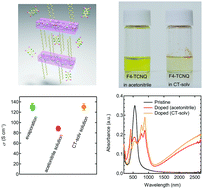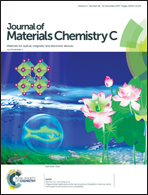Molecular doping in organic semiconductors: fully solution-processed, vacuum-free doping with metal–organic complexes in an orthogonal solvent†
Abstract
Chemical doping in π-conjugated organic semiconductors, which involves a redox reaction between a host π-conjugated material and a dopant, is achieved by either co-evaporation, co-dissolved solution, or exposure to a dopant gas. Here, we demonstrate a new route for molecular doping; a thiophene-based semiconducting polymer film can be doped with dopants dispersed in an orthogonal solvent. An increase in conductivity is demonstrated as a result of adopting a strong acceptor dopant, a metal–organic complex, to achieve an efficient charge transfer because the introduced dopant is likely to reside within the polymer lamellae throughout the entire bulk of the organic semiconductor film. Comprehensive magnetotransport and spectroscopic studies confirm that band-like transport is realized in such dopant-implanted conducting polymers. The present method can shed light on molecular doping in materials science because any molecular dopants that are non-evaporative and insoluble can be used with this method.



 Please wait while we load your content...
Please wait while we load your content...